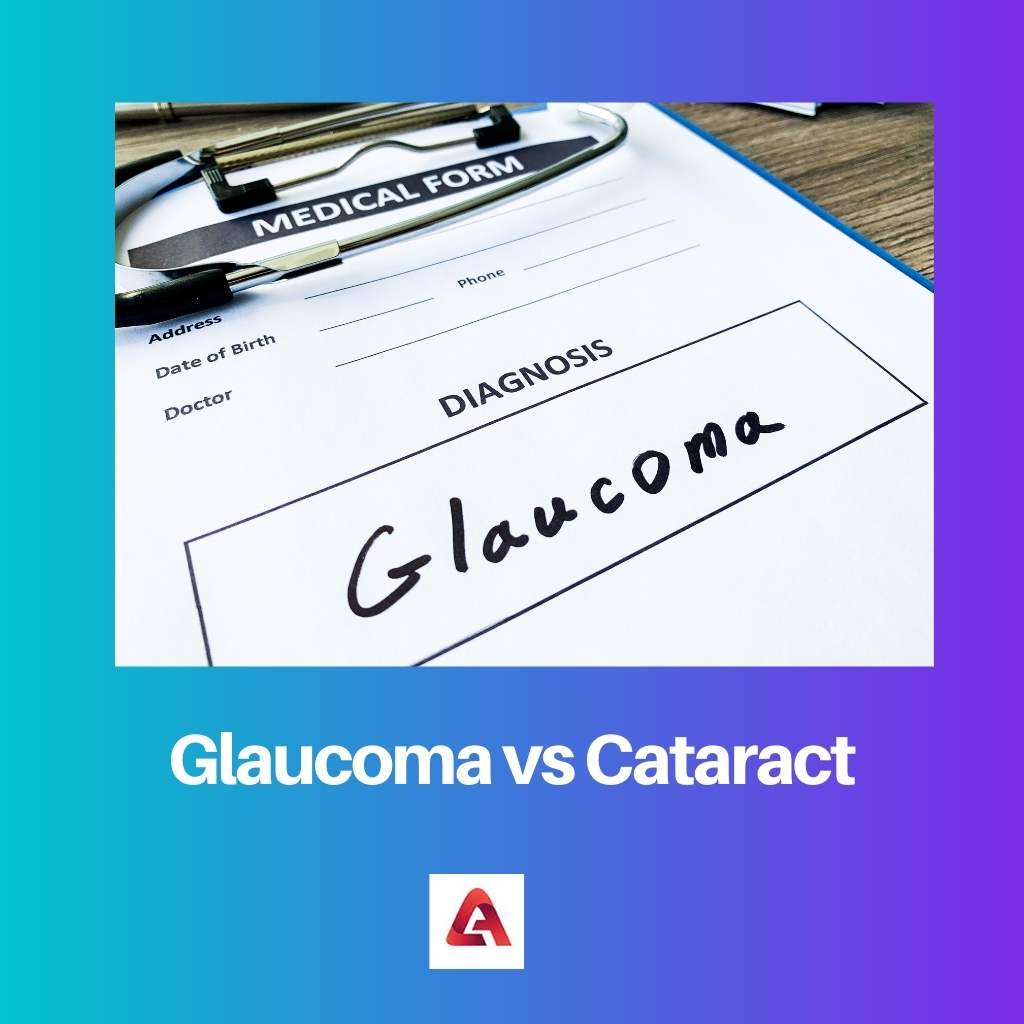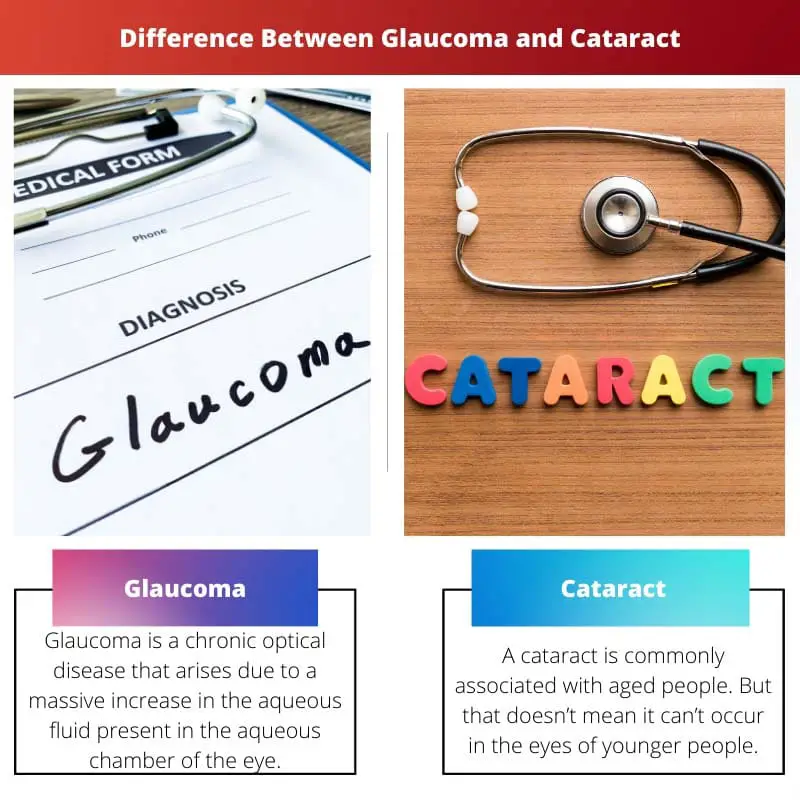Glaucoma and cataract are chronic diseases affecting the eye and its connecting parts.
Given it is a chronic condition, early detection is needed to give the patients the right treatment and prevent the eventual path to blindness.
It’s necessary to have good optic health and checkups to ensure that such diseases are kept at bay.
Key Takeaways
- Glaucoma results from increased intraocular pressure damaging the optic nerve, while cataracts involve the clouding of the eye’s natural lens.
- Glaucoma can cause irreversible blindness if left untreated, whereas cataract-related vision loss can be reversed through surgery.
- Risk factors for glaucoma include age, family history, and race, while cataracts primarily develop due to ageing and exposure to UV radiation.
Glaucoma vs Cataract
Glaucoma is a group of eye diseases that damage the optic nerve, which is responsible for transmitting visual information from the eye to the brain. A cataract is a condition in which the eye’s natural lens becomes cloudy, leading to a decrease in vision, and is a common cause of vision loss.

Glaucoma is a chronic optical disease that arises due to a massive increase in the aqueous fluid present in the aqueous chamber of the eye.
Like everything else, an increase in fluid causes a build-up in the pressure of the container the fluid is in. In the case of the eye, the increase of aqueous fluid increases the pressure on the walls of the that, including the retina and optic nerve.
A cataract is commonly associated with aged people. But that doesn’t mean it can’t occur in the eyes of younger people.
The protein synthesized in the lens tends to accumulate instead of being eliminated, causing the protein to create layers on the lens, thereby blocking a passage of light to the retina.
This results in the loss of vision completely or double vision.
Comparison Table
| Parameters of Comparison | Glaucoma | Cataract |
|---|---|---|
| Loss of Eyesight | Yes, if not treated at the correct time | No, can always be fixed with surgery |
| Sees an Increase of? | Optical fluid | Proteins |
| Site of Action | Aqueous chamber | Optic lens |
| Symptoms | Eye pain, redness, nausea | Cloudy vision, double vision |
| Genetically Inherited | Could be | Does not have a probability to inherited |
What is Glaucoma?
Glaucoma is a disease that concerns the eye and relates to pressure changes in it.
There are fluids in the eye that help in the transfer of light rays and help in the shock absorption property of the eye.
The aqueous chamber of the eye is filled with aqueous humour, the fluid in the anterior part of the lens.
As the fluid increases, if the eye loses the ability to drain out the present fluid methodically, it leads to accumulation.
This accumulation of aqueous humour leads to a build-up of pressure in the surrounding walls of the eye.
When the eye can’t release the excess fluid, the increase in pressure on the optic nerve due to the surrounding medium is called intraocular pressure.
The pressure tends to create a block in the optic nerve that transmits the images to the brain for decoding.
Eventually, a patient might have slight symptoms that might not correlate to glaucoma.
Symptoms include blurry vision, nausea, redness in the eye, and a bulging sensation in the eye.
If a patient’s eyesight is lost completely due to glaucoma, there are no probabilities to bring it back.
In the case of glaucoma, vision could be considered permanently lost at the last stages of the disease.
As a patient reaches the end stages of this chronic disorder, there is no permanent cure that has been discovered as of now.
Glaucoma can be considered genetically inherited through generations of a family.
But it is not always inherited from parent to child or from grandparents to grandkids.
It could be acquired in a person’s lifetime due to lifestyle activities like greater time spent in front of a screen like laptops etc.
In a study, it could be figured that almost 15% of people with glaucoma tend to lose their eyesight completely.
Some surgeries help in draining out the extra fluid. This can only be possible in the early stages of glaucoma.
Later on, surgeries can’t help someone who has already lost their vision. Blindness is permanent in such cases.

What is Cataract?
A cataract is seen in older people with a lower ability to use synthesized body proteins.
The optic lens creates proteins that are needed to carry out its functions.
At a point, the optic lens can’t use the proteins in their designated form, and the proteins accumulate on the surface of the lens.
This accumulation of proteins is what leads to cataracts.
Such protein accumulation leads to a white, yellow, or brown-like layer that gives a cloudy vision to the patient.
Symptoms of cataracts include cloudy vision, lack of vision at night, double vision, etc.
Surgeries are a safe option in case of cataracts as they have been proven to be 100% successful.
Cataracts won’t lead to a permanent loss of vision as surgeries are a sure option to clear the issue posed by the optic lens.
The protein-accumulated lens is removed during the surgery, and either an artificial or a donor lens is taken to replace the original lens.
Usually, artificial lenses are used as donor lenses that need to be compatible with the receiver, and such have chances of infection.
Over 46% of older citizens in the world are cataracts ridden, and the number keeps increasing over the years.
It’s rare for younger people to have cataracts as their protein metabolism remains intact.
But there are cases of youngsters coming in with cataract-like symptoms that have been persisting for some time.

Main Differences Between Glaucoma and Cataract
- While glaucoma is a disease related to eye pressure and the optic nerve, cataracts are related to protein accumulation and optic lenses.
- Cataract surgeries are a pretty effective cure for the disease, while surgeries are done for glaucoma only extend the eyesight period.
- Permanent vision loss is a huge possibility in the case of glaucoma due to ineffective treatments that have been found so far, but in the case of cataracts, due to effective surgery and medical assistance, permanent blindness is not a surety.
- Cataract set in during old age and is rare in youngsters, but glaucoma has no age and can happen to anyone.
- While cataract surgery removes and replaces the lens, glaucoma surgery can help create a passage for the drainage of excess fluid.


Useful information. I found the table of comparison very helpful to understand the differences more easily.
The article is quite compelling and offers a great insight into glaucoma and cataracts.
This article provides a clear understanding of the two conditions. The comparison in symptoms, treatment and risk factors is very beneficial in distinguishing the two more effectively.
A very detailed and thorough article. I found the information quite enlightening.
Great article, very informative and provides a comprehensive distinction between glaucoma and cataracts. I believe is very useful for anyone who wants to understand the main differences between these two eye conditions.
I totally agree, this article is very helpful. It also provides a deep insight into the symptoms and risk factors. It’s a must-read.